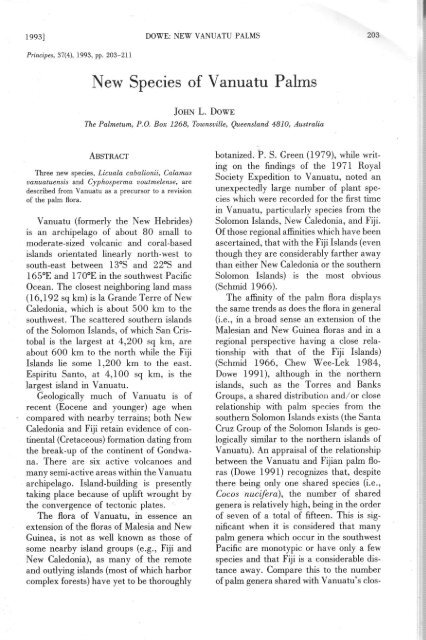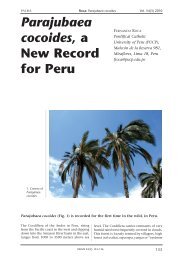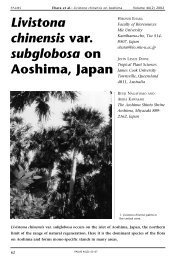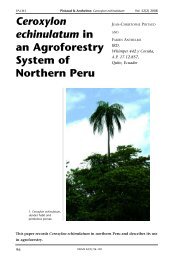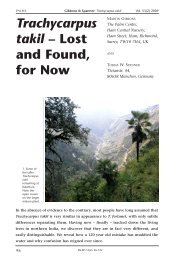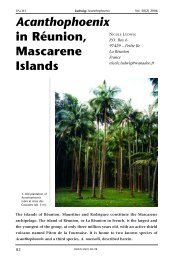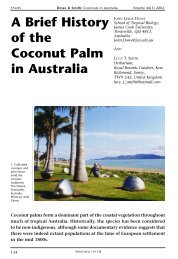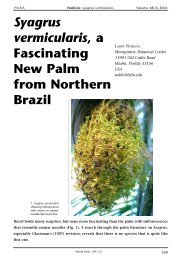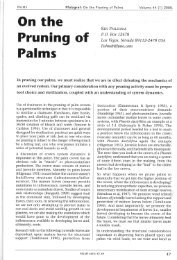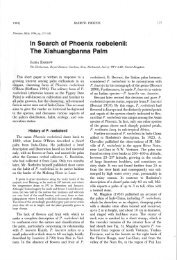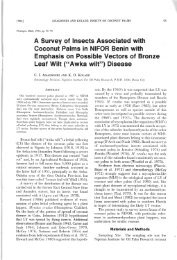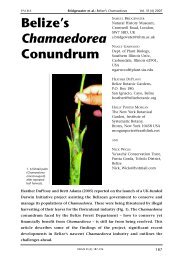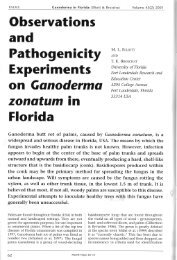New Species of Vanuatu Palms - International Palm Society
New Species of Vanuatu Palms - International Palm Society
New Species of Vanuatu Palms - International Palm Society
You also want an ePaper? Increase the reach of your titles
YUMPU automatically turns print PDFs into web optimized ePapers that Google loves.
9931<br />
DOWE: NEW VANUATU PALMS<br />
Principes, 37(4), I993, pp. 203-2ll<br />
<strong>New</strong> <strong>Species</strong> <strong>of</strong> <strong>Vanuatu</strong> <strong><strong>Palm</strong>s</strong><br />
JoHN L. Dowr<br />
The <strong>Palm</strong>etum, P.O. Box 1268, Tounsaille, Queensland 481O, Australia<br />
Assrnecr<br />
Three new species, Licuala cabalionii, Calamus<br />
aanuatuensis and Cyphosperma aoutmelense, are<br />
described from <strong>Vanuatu</strong> as a precursor to a revision<br />
<strong>of</strong> the palm flora.<br />
<strong>Vanuatu</strong> (formerly the <strong>New</strong> Hebrides)<br />
is an archipelago <strong>of</strong> about 80 small to<br />
moderate-sized volcanic and coral-based<br />
islands orientated linearly north-west to<br />
south-east between l3oS and 22oS and<br />
l65oE and 170"E in the southwest Pacific<br />
Ocean. The closest neighboring land mass<br />
(I6,L92 sq km) is la Grande Terre <strong>of</strong> <strong>New</strong><br />
Caledonia, which is about 500 km to the<br />
southwest. The scattered southern islands<br />
<strong>of</strong> the Solomon Islands, <strong>of</strong> which San Cristobal<br />
is the largest at 4,200 sq km, are<br />
about 600 km to the north while the Fiji<br />
Islands lie some 1,200 km to the east.<br />
Espiritu Santo, at 4,100 sq km, is the<br />
largest island in <strong>Vanuatu</strong>.<br />
Geologically much <strong>of</strong> <strong>Vanuatu</strong> is <strong>of</strong><br />
recent (Eocene and younger) age when<br />
compared with nearby terrains; both <strong>New</strong><br />
Caledonia and Fiji retain evidence <strong>of</strong> continental<br />
(Cretaceous) formation dating from<br />
the break-up <strong>of</strong> the continent <strong>of</strong> Gondwana.<br />
There are six active volcanoes and<br />
many semi-active areas within the <strong>Vanuatu</strong><br />
archipelago. Island-building is presently<br />
taking place because <strong>of</strong> uplift wrought by<br />
the convergence <strong>of</strong> tectonic plates.<br />
The flora <strong>of</strong> <strong>Vanuatu</strong>, in essence an<br />
extension <strong>of</strong> the floras <strong>of</strong> Malesia and <strong>New</strong><br />
Guinea, is not as well known as those <strong>of</strong><br />
some nearby island groups (e.g., Fiji and<br />
<strong>New</strong> Caledonia), as many <strong>of</strong> the remote<br />
and outlying islands (most <strong>of</strong> which harbor<br />
complex forests) have yet to be thoroughly<br />
botanized. P. S. Green (I979), while writing<br />
on the findings <strong>of</strong> the I97l Royal<br />
<strong>Society</strong> Expedition to <strong>Vanuatu</strong>, noted an<br />
unexpectedly large number <strong>of</strong> plant species<br />
which were recorded for the first time<br />
in <strong>Vanuatu</strong>, particularly species from the<br />
Solomon Islands, <strong>New</strong> Caledonia, and Fiji.<br />
Of those regional affinities which have been<br />
ascertained, that with the Fiji Islands (even<br />
though they are considerably farther away<br />
than either <strong>New</strong> Caledonia or the southern<br />
Solomon Islands) is the most obvious<br />
(Schmid 1966).<br />
The affinity <strong>of</strong> the palm flora displays<br />
the same trends as does the flora in general<br />
(i.e., in a broad sense an extension <strong>of</strong> the<br />
Malesian and <strong>New</strong> Guinea floras and in a<br />
regional perspective having a close relationship<br />
with that <strong>of</strong> the Fiji Islands)<br />
(Schmid 1966, Chew Wee-Lek 1984,<br />
Dowe l99I), although in the northern<br />
islands, such as the Torres and Banks<br />
Croups, a shared distribution andlor close<br />
relationship with palm species from the<br />
southern Solomon Islands exists (the Santa<br />
Cruz Group <strong>of</strong> the Solomon Islands is geologically<br />
similar to the northern islands <strong>of</strong><br />
<strong>Vanuatu</strong>). An appraisal <strong>of</strong> the relationship<br />
between the <strong>Vanuatu</strong> and Fijian palm floras<br />
(Dowe l99l) recognizes that, despite<br />
there being only one shared species (i.e.,<br />
Cocos nucifera), rhe number <strong>of</strong> shared<br />
genera is relatively high, being in the order<br />
<strong>of</strong> seven <strong>of</strong> a total o{ fifteen. This is significant<br />
when it is considered that many<br />
palm genera which occur in the southwest<br />
Pacific are monotypic or have only a few<br />
species and that Fiji is a considerable distance<br />
away. Compare this to the number<br />
<strong>of</strong> palm genera shared with <strong>Vanuatu</strong>'s clos-
PRINCIPES<br />
lVoL. 37<br />
I. Juvenile plant <strong>of</strong> Licuala cabalionii with the obvious symmetrical segmentation <strong>of</strong> the leaf.<br />
est neighbor, <strong>New</strong> Caledonia; only two genera<br />
(Cocos and Cyphosperma) <strong>of</strong> a combined<br />
total <strong>of</strong> 25 genera occur in both<br />
areas. Whether Vanualu was or is in a<br />
favored position to receive propagules from<br />
Fiji (i.e., abutting prevailing ocean currents,<br />
in the paths <strong>of</strong> migrational birds,<br />
etc.) has yet to be investigated, although<br />
the uniformity <strong>of</strong> the strand vegetation <strong>of</strong><br />
the region is evidence <strong>of</strong> ocean currents<br />
being a major influence on the distribution<br />
<strong>of</strong> plants in the southwestern Pacific (Gunn<br />
and Dennis 1976, Merrill l98l). Of the<br />
eight genera which are not shared, four<br />
are monotypic, three <strong>of</strong> which are endemic<br />
to Fiji.<br />
A list <strong>of</strong> the recognized <strong>Vanuatu</strong> palm<br />
species, including the three new species<br />
described here, is as follows: ** denotes<br />
susoected or known to be introduced/naturalized<br />
taxa: f denotes endemic taxa: f<br />
denotes indigenous taxa which also occur<br />
elsewhere.<br />
Licuala cabalionii Dowef<br />
L. grandis H. Wendl. ex Linden$<br />
Pritchardia pacif.ca Seem. & H.<br />
Wendl.xx<br />
Metroxylon uarburgii (Heim) Becc.$<br />
M. salomonense (Warb.) Becc.**<br />
Calamus uanuatuensis Dowef<br />
Cctryota albertii F. Muell. ex H. Wendl.<br />
& Drude*x<br />
Veitchia arecina Becc.f<br />
V. macdanielsii H. E. Mooret<br />
V. rnetiti Becc.f<br />
V. montgomeryana H. E. Mooref<br />
V. spiralis H. Wendl.t<br />
V. winin H. E. Mooret<br />
Gulub ia cylind r o c ar pa Becc.$<br />
Pelagodoxa henryana Becc.* x<br />
Clino s ti gma har landii Becc.f<br />
Carpoxylon m,&crospermum H. Wendl. &<br />
Drudef<br />
Physokentia tete (Becc.) Becc.t<br />
Cy pho s p erma u outrnelense Dowet<br />
Cocos nucifera L.$
lee3l<br />
DOWE: NEW VANUATU PALMS<br />
<strong>New</strong> <strong>Species</strong><br />
Licuala cabalionii Dowe, sp. nov. I.<br />
grandi H. Wendl. ex Linden proxissima<br />
a qua lamina foliorum segmentata, caulibus<br />
tenuioribus altioribusque, fructibus<br />
maturis aurantiacis non carmesinis, et<br />
endocarpio parce costato differt. TYPUS:<br />
<strong>Vanuatu</strong>. Malekula: Done 048, 5 Sept.<br />
l99l (holotypus BRI). Figures l-3.<br />
Stem solitary, erect to slightly reclining,<br />
to 5 m tall, to 8 cm diam., portion below<br />
leaves retaining decaying leaf-bases, proximal<br />
portion smooth, light brown,/gray.<br />
Leaves to 12 in a loose crown; petiole very<br />
long and thin, to 3 m long to I cm wide<br />
in distal portion, irregular marginal spines<br />
only at the base; leaf-blade segmented; segments<br />
to 12, symmetrically arranged, central<br />
segment twice or more times broader<br />
than lateral segments which become progressively<br />
narrower toward the leaf margins,<br />
all segments slightly pendulous. Inflorescence<br />
interfoliar, pendulous, to 1.8 m<br />
long, five once-branched branches; bracts<br />
subtending primary and seiondary<br />
branches tubular, remaining green during<br />
fruit development and maturit;'. Flowers<br />
pedicellate, single, spirally arranged, sepals<br />
fused to one-third their length, apex<br />
rounded, to 12 mm long, petals fused<br />
badally, apex valvate, pointed to 4 mm<br />
Iong. Fruit yellow,/orange when ripe, globose,<br />
to l0 mm diam.; endocarp brittle<br />
with few longitudinal ridges. Seed to 6 mm<br />
diam., testa intruding into endosperm below<br />
the raphe. Eophyll plicate, Ieaf dividing<br />
early.<br />
Distribution. <strong>Vanuatu</strong>, on the islands<br />
<strong>of</strong> Vanua Lava (in littoral forest at sealevel<br />
on volcanic soils) and Malekula (in<br />
rainforest to 250 m above sea level on<br />
volcanic soils). Endemic.<br />
Specimens Examined. VANUATU.<br />
"Amethyst<br />
SOUTH MALEKULA:<br />
Camp,"<br />
250 m in rainforest on volcanic soil, 5<br />
Sept. 1991, Dowe 048 (holotype BRI).<br />
Typif.cation. Although this taxon had<br />
been recognized, by the author to be dis-<br />
2. Licuala cabalionji in rainforest at altitude <strong>of</strong><br />
about 200 m at Amethyst Camp, southern Malekula.<br />
tinct in 1988, no suitable sample for typification<br />
was available until that collected<br />
on 5 September l99I (Doue 048,BRI).<br />
This collection consists <strong>of</strong> two leaves (one<br />
with petiole) and a complete infructescence<br />
with immature fruit. Mature fruit has been<br />
seen by the author in the field but no<br />
sample <strong>of</strong> it has been preserved.<br />
Deriuation <strong>of</strong> Nant.e. Licuala cabalionii<br />
is named for Pierre Cabalion (born<br />
1947 ), French ethnopharmacologist whose<br />
work in <strong>Vanuatu</strong> has been an important<br />
contribution to the Flora <strong>of</strong> <strong>Vanuatu</strong> Project.<br />
Licuala comprises about I I0 species<br />
distributed from northeast India, through<br />
southern China, Philippines and southeast
PRINCIPES<br />
[Vor. 37<br />
3. Prolific production <strong>of</strong> seedlings below the "parent" plants is characteristic oI Licuala cabalionii.<br />
Asia to <strong>New</strong> Guinea, northern Australia,<br />
Solomon Islands and <strong>Vanuatu</strong>. The genus<br />
has developed its greatest diversity in Malay<br />
Peninsula and Borneo (about 50 species)<br />
and <strong>New</strong> Guinea (about 36 species)' Iicuala,<br />
was not recognized as occurring in<br />
<strong>Vanuatu</strong> until I970, when I. grand'is was<br />
collected from southern Espiritu Santo<br />
(Whitmore 1973). Erroneously this species<br />
had been documented in numerous<br />
publications as originating from <strong>New</strong> Britain,<br />
an island to the east <strong>of</strong> <strong>New</strong> Guinea,<br />
an error most probably originating from<br />
its initial description from a horticultural<br />
source.<br />
Licuala cabalionii is distinguished from<br />
the closest occurring species, L. grandis<br />
H. Wendl. ex Linden (distributed throughout<br />
much <strong>of</strong> <strong>Vanuatu</strong> as well as the Santa<br />
Cruz Group and San Cristobal Island <strong>of</strong><br />
the Solomon Islands) by its divided leafblade,<br />
less spiny petiole, shorter floral pedicel<br />
and sparingly as opposed to multi<br />
ribbed endocarp. L. lauterbachii Darnmer<br />
& K. Schum. (Solomon Islands and <strong>New</strong><br />
Guinea) differs in having a short and erect<br />
inflorescence, red fruit' and irregularly<br />
divided leaf-blade.<br />
The known populations <strong>of</strong> L. cabalionii<br />
do not occur close to populations <strong>of</strong> Z.<br />
grandis although they occupy similar habitats.<br />
The former occurs in very dense<br />
colonies (almost monospecific) in primary<br />
rainforest; the forest floor in the vicinity<br />
is thickly cover with seedlings and small<br />
plants. I. grandis is much less gregarious,<br />
with very few seedlings being observed and<br />
individuals being relatively widely spaced.<br />
L. grandis is more commonly found in<br />
disturbed or secondary forest. No traditional<br />
uses or vernacular names have been<br />
recorded for L. cabaLionii.<br />
Licuala cabalionii has appeared as the<br />
manuscript names "Licuala sp. Vanua<br />
Lava" (Dowe 1989a) and "Licuala sP."<br />
(Dowe 1989b).<br />
Calamus vanuatuensis Dowe, sp.<br />
nov. C. aitiensi Warb. ex Becc. et C.
I<br />
r9931<br />
DOWE: NEW VANUATU PALMS<br />
4. Calamus uanuatuensis is a cirrate climber, seen here in the low altitude forest <strong>of</strong> central EsPiritu<br />
Santo. 5. Leaflets <strong>of</strong> Calamus Danuatuensis are characteristically broad and chartaceous in appearance.<br />
hollrungii Becc. affinis; a C. uitiense spinis<br />
in pectine non nisi in juvenalibus, ligula in<br />
pagina abaxiali petioli fructibus maturis<br />
cremeis majoribusque distinguitur; a C.<br />
hollrungii foliolisque non spinescentibus,<br />
et fructibus multo majoribus distinguitur.<br />
TYPUS: <strong>Vanuatu</strong>. Erromango: Chew Wee-<br />
Leh(RSNII) 118(1& 2),3 August l97l<br />
(holotypus PVV; isotypus K). Figures 4-7.<br />
High climbing solitary-stemmed rattan.<br />
Stem without sheath bright green, glossy,<br />
10-50 mm diam., narrowing above the<br />
nodes. Sheaths dull green to coppery/<br />
brown, densely spiny particularly toward<br />
the knee and petiole; spines green to yel-<br />
Iowish green, Iight brown to almost black,<br />
to 4 cm long, irregularly spaced, robust<br />
and infrequently in combs in juvenile plants;<br />
knee prominent, spineless, but spines<br />
densely aggregated near its margins. Leaf<br />
cirrate, to 4 m long; cirrus thick, to 2 m<br />
long, bi- to five-clawed on all surfaces;<br />
petiole 7-30 cm long, with spines on margins<br />
and adaxial surface; ligule prominent<br />
on adaxial surface <strong>of</strong> petiole base; rachis<br />
spineless in median portion, but with clawed<br />
spines developing on abaxial surface <strong>of</strong><br />
distal portion; leaflets regularly arranged,<br />
well spaced, coriaceous, dark green on both<br />
surfaces, 45 x 12 cm, four- to seYenveined,<br />
apex acute, spinelesso terminal pair<br />
in non-cirrate juvenile leaf united basally.<br />
Inflorescence to 2 m long, non-flagellate,<br />
pendulouso with about six branches; staminate<br />
inflorescence smaller than pistillate<br />
inflorescence; bracts persistent, green, basal<br />
portion narrow, apical portion funnelshaped,<br />
truncate, with marginal spines,<br />
rachillae to I2 cm long, curved, alternate<br />
and distichous, about 24 per branch. Flow-
208 PRINCIPES lvor. 37<br />
6. The petiole and upper leaf-sheath ol Calamus oanuatuensis. Note the spineless knee which is characteristic<br />
<strong>of</strong> the species. 7. Infructescence <strong>of</strong> Calamus uanuatuensis.<br />
ers pedicellate; staminate flowers closely<br />
spaced, subtended by prominent funnelshaped,<br />
truncate bracts; pistillate flowers<br />
8- l2 per each side <strong>of</strong> rachillae, to I 5 mm<br />
Iong, staminodes prominent. Fruit sub-globose<br />
to 20 mm long, stigmatic remains<br />
prominent, white or cream suffused at<br />
maturity, scales arranged in seven rows.<br />
Seed pebbled, basally depressed, raphe<br />
prominent. Eophyll bifid.<br />
Distribution. VanuaLu, occurring on<br />
most islands between Erromango and<br />
Vanua Lava in moist forests from sea-level<br />
to an altitude <strong>of</strong>over 1,000 m on a variety<br />
<strong>of</strong> soil types but most commonly in forest<br />
on basalt at 200-300 m. Endemic.<br />
Specimens Examined. VANUATU.<br />
ERROMANCO: Nouankao River, agathis<br />
forest at 150 m, Cheu; Week-Lek (RSNII)<br />
118 (1 & 2), 3 August l97I (holotype<br />
PVV; isotype K); Southeast, in kauri forest<br />
200-300 m, Schmid.3272,12 May 1970<br />
(NOU); River 5 km southwest <strong>of</strong> lpota,<br />
Cabalion 3028, l6 November I985<br />
(PVV). EFATE: Loukpat, near Tagabe,<br />
dense forest about 200 rn, Green (RS1VI4<br />
1076 (1-4), 11 July l97l (PVV); South,<br />
Rentabao River in secondary forest on redbrown<br />
soils at sea-level, Schrnid 327 I (2<br />
sheets) 29 April I970 (NOU); Mt. Bernier<br />
at 470 m, Seoule 38, 12 August I98I<br />
(PVV). PENTECOST: valley to the south<br />
<strong>of</strong> Melsisi, Cabalion 1153,3 October 1980<br />
(NOU). BANKS GROUP: Vienne s.n.,<br />
1972 (NOU). MOTA LAVA: 300 m,<br />
Bourret 216,May 1978 (NOU).<br />
Typif,cation. The earliest known collection<br />
<strong>of</strong> this taxon is that by D. Levat,<br />
I883, conserved at Montpellier University<br />
(MPU), France. The next recorded collections<br />
were those made in the 1970's by<br />
botanists from ORSTOM, based in Noumea,<br />
<strong>New</strong> Caledonia and collectors involved<br />
in the 197 I Royal <strong>Society</strong> and Percy
9931 DOWE: NEW VANUATU PA,LMS 209<br />
Sladen Expedition, <strong>New</strong> Hebrides. It is from<br />
this expedition that the type specimen has<br />
been chosen: Chew Wee-Lek I I B, 3 August<br />
1971, consisting <strong>of</strong> two parts; (1) a basal<br />
leaf section (including petiole), a packet <strong>of</strong><br />
oistillate flowers and a section <strong>of</strong> infruci"r"".r""<br />
with fruit and (2) a mid leaf seclion<br />
and a section <strong>of</strong> infructescence with<br />
fruit; this is the most complete and representative<br />
collection seen by the author;<br />
it is preserved at PVV with a duplicate at<br />
K. The only collection to contain staminate<br />
flowers is Schmid 3271, 29 April 1970,<br />
preserved at NOU.<br />
Deriuation <strong>of</strong> lYame. Calarnus uanuatuensis<br />
is named for <strong>Vanuatu</strong>, the type<br />
locality.<br />
Discussion. This species has a relatively<br />
widespread occurrence and is variable.<br />
Samples collecied from higher altitudes and<br />
from the northern parts <strong>of</strong> its range display<br />
a smaller overall size. It appears most<br />
closely related to C. uitiensis Warb. ex<br />
Becc., an endemic Fijian species and C.<br />
hollrungii Becc. from northeast Queensland,<br />
<strong>New</strong> Guinea and the Solomons. C.<br />
uitiensis has basally aggregated and<br />
obliquely arranged spines, a shorter and<br />
more robust pistillate inflorescence, smaller<br />
fruits which are whitish at maturity, and<br />
lacks the <strong>of</strong>ten prominent ligule on the<br />
adaxial surface at the base <strong>of</strong> the petiole.<br />
C. hollrungii has leaflets aggregated into<br />
groups (2-5) and which have marginal and<br />
and a leafsheath with a spinous<br />
I'}":lt"*<br />
Distinguishing Features <strong>of</strong><br />
Three Calamus <strong>Species</strong><br />
C. uanuatuensis C. uitiensis C. hollrungii<br />
leaflets evenly leaflets evenly leaflets<br />
arranged<br />
arranged<br />
:::"r""Ji]<br />
leaflets unarmed t"ir1"",;.-"U leaflets armed<br />
sheath spines not sheath spines sheath spines<br />
in combs in combs not in combs<br />
knee unarmed knee unarmed knee armed<br />
inflorescencelong inflorescence<br />
short<br />
inflorescence<br />
long<br />
fruit 2 cm long fruit 1.5 cm fruit I cm long<br />
rong<br />
fruit cream fruit white fruit white<br />
Calamus L. is the largest genus in the<br />
<strong>Palm</strong>ae with about 380 species distributed<br />
in tropical Africa (one species), eastern and<br />
southern India through Burma, southern<br />
China, Philippines, south-east Asia, Malesia,<br />
<strong>New</strong> Guinea, Solomons, northern and<br />
eastern Australia, Fiji and <strong>Vanuatu</strong>. The<br />
greatest concentration <strong>of</strong> species occurs in<br />
Malesia. The few species occurring in the<br />
Solomons, Fiji, <strong>Vanuatu</strong> and eastern Australia<br />
represent outliers; apart from the<br />
three species noted above, other outlying<br />
species in Australasia/western Pacific<br />
appear not to be closely related.<br />
Calamus uanuatuensis has appeared as<br />
manuscript names as follows:<br />
Calamus sp. 'Efate' (Guillaumin l94B)<br />
Calamus (Schmid 1965)<br />
Calamus (Moore 1966)<br />
Calamus (Schmid 1973a)<br />
Calamus sp.'Erromango Sud-Est' (Schmid<br />
1973b)<br />
Calamus sp. 'Vat6-Sud' (Schmid 1973b)<br />
Calarnus sp. (Schmid 1974a)<br />
Calamus sp. (Schmid 1974b)<br />
Calamus sp. (Hodel 1982)<br />
C. sp. aff. uitiensis (Dowe 1989a)<br />
Calamus sp. (Cabalion 1989)<br />
Calamus sp. (Dowe l99l)<br />
Cyphosperma voutmelense Dowe,<br />
sp. nov. C. balansae (Brongn.) H. Wendl.<br />
ex Salomon proximissa a qua statura aliquantum<br />
minore, inflorescentia dimidio<br />
breviore squamis persistentibus obtecta,<br />
bracteis subtendentibus ramos inflorescentiae<br />
humilibus rotundatisque, et fructibus<br />
multo minoribus distinguitur. TYPUS:<br />
<strong>Vanuatu</strong>. Espiritu Sanro: Morat 6488,<br />
August 1979 (holotypus NOU; isotypus<br />
BH).<br />
Stems solitary, to 6 m tall, markedly<br />
cylindrical, leaf-scars closely spaced. Leaf
210 PRINCIPES [VoL. 37<br />
to 1.5 m long; leaf-base smooth, not forming<br />
a crownshaft; petiole narrowing<br />
abruptly, deeply channelled adaxially,<br />
rounded abaxially; leaflets widely spaced<br />
on rachis, to 5 cm apart, falcate, acuminate,<br />
to 45 x 3 cm, mid-rib prominent;<br />
two pronounced lateral ribs, equidistant<br />
from mid-rib and leaf margin; mid-rib with<br />
brown scales below, only at the base. Inflorescences<br />
interfoliar, arching to pendulous,<br />
to 92 cm long; prophyll to 30 cm<br />
long, open abaxially and not fully encircling<br />
peduncle at attachment; peduncular<br />
bract, attached 2-2.5 cm above prophyllar<br />
attachment, to 55 cm long, becoming<br />
fibrous with age; rameal bract to 4 cm<br />
long, pointed, attached 12 cm above<br />
peduncular attachment; all bracts persistent;<br />
peduncle to 35 cm long, to l0 mm<br />
wide, adaxially flat, abaxially rounded,<br />
covered with persistent brown scales;<br />
rachillae, about 13 per inflorescence, to<br />
25 cm long, angled, covered with persistent<br />
brown scales, rachillae becoming closer<br />
spaced toward inflorescence apex; inflorescence<br />
branches subtended by low<br />
rounded bracts. Flowers spirally arranged,<br />
triads in the basal one-quarter to one-third,<br />
paired or solitary staminate flowers distally;<br />
staminate flowers symmetrical, larger<br />
than pistillate flowers, sepals imbricate to<br />
I mm long, petals valvate to 3 mm long,<br />
stamens 6; pistillate flowers to 2 mm high<br />
and wide, sepals imbricate with smooth<br />
margins; bracteoles large. Fruit sub-globose<br />
[0 x 8 mm, red at maturity, stigmatic<br />
remains subapical; endocarp ridged<br />
and furrowed. Seed 6 x 4 crr', in shape<br />
similar to endocarp.<br />
Distribution. <strong>Vanuatu</strong>, on Espiritu Santo<br />
where it is known from a small population<br />
on the Cumberland Peninsula on a ridge<br />
below Voutm6l6 Peak (1,535 m) in moist<br />
forest on volcanic soils at 900-1,100 m.<br />
Endemic.<br />
Specimens Exam.ined. VANUATU.<br />
ESPIRITU SANTO: Cumberland Peninsula,<br />
ridge below Voutm6l6 Peak in forest<br />
on volcanic soils at 1,000 m, Morat 6488<br />
(5 sheets), 3 August 1979 (holotype NOU;<br />
isotype BH).<br />
Typifcation. The only collection <strong>of</strong> this<br />
taxon is Morat 6488, 3 August 1979,<br />
preserved at NOU and BH. The sample<br />
at NOU consists <strong>of</strong> five sheets <strong>of</strong> which<br />
three comprise a complete leaf, the<br />
remaining two are complete inflorescences<br />
both with staminate and pistillate flowers.<br />
Fruit and a section <strong>of</strong> inflorescence are<br />
oreserved at BH.<br />
Deriuation <strong>of</strong> Name. Cyphosperrna<br />
uoutmelense is named for Voutm6l6 (also<br />
spelt Vutm6l6 and Vutim6l6), a peak above<br />
the ridge from where the type specimen<br />
was collected.<br />
Discussion. Cyphosperma aoutmelen'<br />
se is most closely related to C. balansae<br />
from <strong>New</strong> Caledonia, from which it differs<br />
by its much smaller inflorescence, brown,<br />
scaly inflorescence branches, rounded and<br />
not prominent inflorescence branch bracts<br />
and smaller fruit. The two Fijian species<br />
are more distinct: C. tanga H. E. Moore<br />
has undivided or only apically divided leaves<br />
and a sparsely branched inflorescence while<br />
C. trichospadir (Burret) H. E. Moore has<br />
a distinct crownshaft, an infrafoliar inflorescence,<br />
and large fruit to 2 cm long.<br />
Cyphosperma uoutmelense has<br />
appeared in manuscripts under the following<br />
titles:<br />
Cyphospernta sp. o<strong>New</strong> Hebrides' (Moore<br />
& uhr r9B4)<br />
Cyphospermasp.'<strong>Vanuatu</strong>' (Dowe I 989b)<br />
Cyphosperrna cf. balansae (Cabalion<br />
l9B9)<br />
Cyphospermo sp. (Dowe l99l)
ee3l DOWE: NEW VANUATU PALMS 2tl<br />
Key to <strong>Species</strong> <strong>of</strong> Cyphosperma<br />
l. Crownshaft developed; inflorescence infrafoliar<br />
Vanua Lava, Taveuni, Fiji .,. C. trichospadix<br />
l. Crownshaft undeveloped; inflorescence interfoliar<br />
2. Peduncle greater than I m long<br />
3. Leaf undivided except irregularly toward<br />
the apex fruit oblong,/ellipsoidal to 1.3<br />
cm long ....-... Vitu Levu, Fiji . . . C. tanga<br />
3. Leaf divided regularly throughout fruit<br />
globose to 1.2 cm diameter<br />
<strong>New</strong> Caledonia ... C. balansae<br />
2. Peduncle less than I m long<br />
Espiritu Santo, <strong>Vanuatu</strong> , . . C. uoutmelense<br />
Acknowledgments<br />
I must thank Dr. Pierre Cabalion <strong>of</strong><br />
ORSTOM, Paris, for his encouragement,<br />
discussion and sustained interest in the<br />
<strong>Vanuatu</strong> Flora; Mr. Chanel Sam <strong>of</strong><br />
ORSTOM, Port Vila, <strong>Vanuatu</strong>, for access<br />
to the Tagabe Herbarium (PVV) and other<br />
general assistance; Dr. Tanguy Jaffre <strong>of</strong><br />
ORSTOM, Noumea, <strong>New</strong> Caledonia, for<br />
access to the Noumea Herbarium (NOU);<br />
Mr. John Crook <strong>of</strong> the Department <strong>of</strong> Forestry,<br />
Port Vila, <strong>Vanuatu</strong>; Dr. Les Pedley<br />
<strong>of</strong> the Queensland Herbarium, Brisbane,<br />
for assisting with the Latin diagnoses; Dr.<br />
Gordon Guymer <strong>of</strong> the Queensland Herbarium<br />
for general assistance and access<br />
to Herbarium (RBI); Dr. John Dransfield<br />
<strong>of</strong> Royal Botanic Gardens, Kew, for critically<br />
reviewing the manuscript; members<br />
<strong>of</strong> the <strong>Palm</strong> and Cycad Societies <strong>of</strong> Australia<br />
for granting me use <strong>of</strong> the word<br />
processing equipment and funding for correspondence<br />
and stationary needs; and the<br />
Yves Rocher Foundation, Paris, France,<br />
for funding the field trip <strong>of</strong> September<br />
I 99r.<br />
LrrpRerunn Cmen<br />
CeseiloN, P. 1989. <strong>Vanuatu</strong> palms: their distri.<br />
bution and uses. 12.' J. L. Dowe (ed.). <strong><strong>Palm</strong>s</strong> <strong>of</strong><br />
the south-west pacific. Publication Fund, <strong>Palm</strong><br />
& Cycad Societies <strong>of</strong> Australia, Milton, pp. 176-<br />
I91.<br />
CHEwWEE-LEK. I984. Landflora. 1z;P. Stanbury<br />
and L. Bushell (eds.). South Pacific islands. The<br />
Macleay Museum, University <strong>of</strong> Sydney, pp.<br />
34-42.<br />
Dowr, J. L. 1989a. <strong><strong>Palm</strong>s</strong> <strong>of</strong> the south-west pacific:<br />
their origin, distribution and description. In; J.<br />
L. Dowe (ed.). <strong><strong>Palm</strong>s</strong> oI the south-west Pacific.<br />
Publication Fund, <strong>Palm</strong> and Cycad Societies <strong>of</strong><br />
Australia, Milton, pp. l-155.<br />
1989b. The unexpected rediscovery <strong>of</strong><br />
Carpoxylon macrospermutn. Principes 33(2):<br />
63-67.<br />
199I. The palms <strong>of</strong> <strong>Vanuatu</strong> and Fiji:<br />
notes on distribution, classification and taxonomy.<br />
Mooreana 1(1): I3-20.<br />
Gnnnn, P. S. 1979. Observations on the phyto.<br />
geography <strong>of</strong> the <strong>New</strong> Hebrides, Lord Howe<br />
Island and Norfolk Island. 1z: D. Bramwell (ed.).<br />
Plants and islands. Academic Press, London, pp.<br />
4 I -53.<br />
GuInauutN, A. 1948. Compendium de la flore<br />
phan6rogamique des Nouvelles-H6brides. Annales<br />
du mus6e colonial de Marseille ann6es 1947 et<br />
194a. 5/6: 5-56.<br />
GUNN, C. R. AND J. V. DENNIS. I976. World guide<br />
to tropical drift seeds and fruits. Demeter Press,<br />
<strong>New</strong> York.<br />
HoDEL, D. 1982. In search <strong>of</strong> Carpoxylon. Principes<br />
26(l): 34-41.<br />
Mrnnrrr, E. D. 1981. Plant life <strong>of</strong> the Pacific<br />
world. Charles Tuttle & Co. Tokyo.<br />
Moonn, H. E., JR. 1966. <strong>Palm</strong> hunting around the<br />
world. Principes I0(2, 3): 64-85.<br />
eNo N. W. UHL. 1984. The indigenous<br />
palms <strong>of</strong> <strong>New</strong> Caledonia. Allertonia 3(5): 314-<br />
402.<br />
ScHurn, M. 1965. Espdces v6g6tales observ6es i<br />
Vat6 (ORSTOM, Noumea).<br />
1966. Note sur la v6g6tation de I'Ile de<br />
Vat6 (ORSTOM, Noumea).<br />
1973a. Espdces de v6g6taux sup6rieurs<br />
observes i Vat6 - Nouvelles-H6brides (ORSTOM.<br />
Noumea),<br />
1973b. Phan6rogam6s des Nouvelles-<br />
H6brides (ORSTOM, Noumea).<br />
1974a. Florule de Erromango (ORSTOM,<br />
Nournea).<br />
1974b. Florule de Pentec6te (ORSTOM,<br />
Noumea).<br />
WHIrruont, T. C. 1973. <strong><strong>Palm</strong>s</strong> <strong>of</strong> Malaya. Oxford<br />
University Press, Kuala Lumpur.


